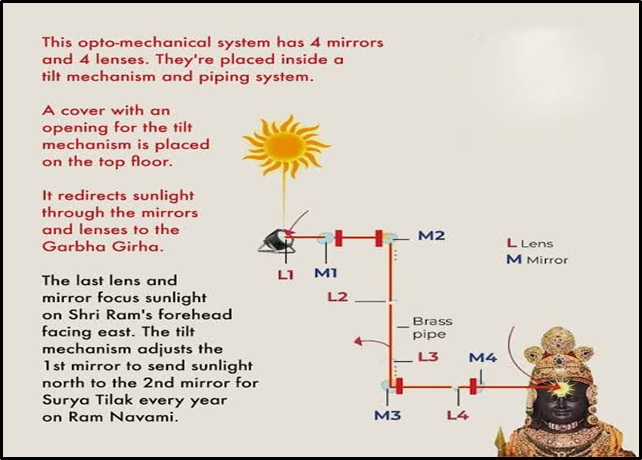SUNLIGHT, SCIENCE & STATE:PUBLIC INSTITUTIONS’ ROLE IN SURYA TILAK PROJECT SPARKS DEBATE
Syllabus:
GS-II:
Science and Technology- Developments and their Applications and Effects
Why in the news?
Surya Tilak project at Ram temple prompts scrutiny over involvement of publicly funded institutions, challenging secular norms.
source:scllorden
Focus:
- The Surya Tilak project at the Ram temple in Ayodhya has garnered public interest recently due to its unique nature.
- It involves directing sunlight onto the forehead of the idol during the festival of Ram Navami using a specially designed mechanism.
- The festival follows a lunisolar calendar, making the calculation of the appropriate date a challenging task.
- The project requires precise calculations and design to ensure that sunlight falls accurately on the idol each year.
What is the Surya Tilak Project?
About Indian Institute of Astrophysics (IIA):
What is the Uniqueness of Ram Temple?
|
About The Surya Tilak Project: Examining the Role of Publicly Funded Institutions:
- Involvement of Publicly Funded Institutions:
- The necessary equipment for the project was set up by scientists and engineers from two government-funded organisations, the Indian Institute of Astrophysics (IIA) in Bengaluru and the Central Building Research Institute (CBRI) in Roorkee.
- IIA is an autonomous institute funded by the Department of Science and Technology (DST), while CBRI is a government institution under the Council of Scientific and Industrial Research.
- The involvement of these institutions raises questions about the appropriateness of government-funded bodies participating in projects with explicit politico-religious connotations.
- Public institutions have traditionally refrained from engaging in explicitly religious activities to uphold the secular character of the state.
- Challenges and Technical Expertise:
- The project entails complex calculations and design to ensure that sunlight falls precisely on the idol’s forehead each year.
- Calculations for a lunisolar calendar can be challenging but are feasible with modern technology and apps.
- The design of the mechanism requires expertise in optics, telescopes, and precision engineering.
- Scientists and engineers at the involved institutions showcased their technical skills in designing and setting up the mechanism.
- The project highlights the intersection of science, technology, and religious beliefs, posing challenges for maintaining the secular character of public institutions.
- Ethical and Constitutional Considerations:
- The involvement of publicly funded institutions in a project with explicit religio-political overtones raises ethical and constitutional concerns.
- Since independence, India has largely adhered to the principle of secularism, prohibiting public institutions from engaging in explicitly religious activities.
- The Surya Tilak project blurs the line between religion and science, challenging the ethical and constitutional norms of the country.
- The project’s endorsement by government-funded bodies raises questions about the neutrality and secular character of public institutions.
- It underscores the need to uphold the principles of secularism and avoid the politicisation of scientific research and institutions.
- Alternative Approaches:
- The Ram temple authority could have organised a competition to find technical solutions for the project, funded by private individuals or the temple trust.
- Scientists associated with institutions like IIA could have volunteered to evaluate and implement the solutions independently.
- Leveraging resources like Atal Tinkering Laboratories could have facilitated the hardware implementation of the chosen design without involving government-funded bodies.
- Exploring alternative approaches would have avoided the politicisation of scientific institutions and upheld the secular ethos of the state.
Conclusion:
- The Surya Tilak project exemplifies the complex interplay between science, religion, and politics in India.
- The involvement of publicly funded institutions raises questions about the secular character and neutrality of such bodies.
- It underscores the importance of upholding ethical and constitutional norms in scientific research and institution-building.
- Exploring alternative approaches could help prevent the politicisation of public institutions and uphold the secular ethos of the country.
Mains Practice Question:
Critically analyse the ethical and constitutional dimensions of publicly-funded institutions’ participation in religious projects, as illustrated by the Surya Tilak initiative discussed by Gautam I Menon. Evaluate the challenges to secularism and state neutrality, and propose alternative strategies to ensure the adherence to constitutional principles in such contexts.




